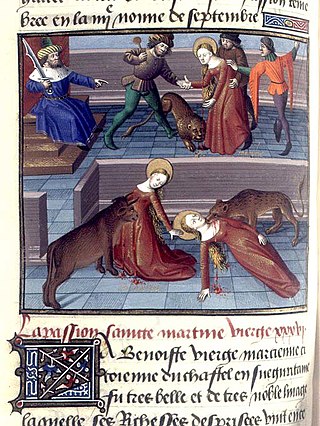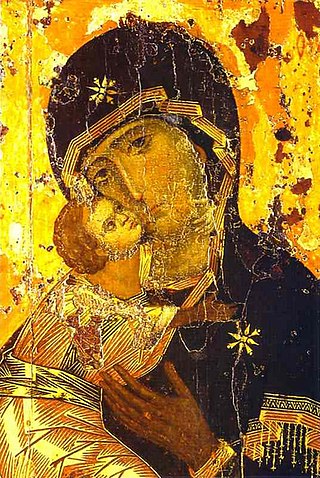
Canonization is the declaration of a deceased person as an officially recognized saint, specifically, the official act of a Christian communion declaring a person worthy of public veneration and entering their name in the canon catalogue of saints, or authorized list of that communion's recognized saints.

An icon is a religious work of art, most commonly a painting, in the cultures of the Eastern Orthodox, Oriental Orthodox, and Catholic churches. The most common subjects include Jesus, Mary, saints, and angels. Although especially associated with portrait-style images concentrating on one or two main figures, the term also covers most of the religious images in a variety of artistic media produced by Eastern Christianity, including narrative scenes, usually from the Bible or the lives of saints.

In Christian belief, a saint is a person who is recognized as having an exceptional degree of holiness, likeness, or closeness to God. However, the use of the term saint depends on the context and denomination. In Catholic, Eastern Orthodox, Anglican, Oriental Orthodox, and Lutheran doctrine, all of their faithful deceased in Heaven are considered to be saints, but a selected few are considered worthy of greater honor or emulation. Official ecclesiastical recognition, and veneration, is conferred on some denominational saints through the process of canonization in the Catholic Church or glorification in the Eastern Orthodox Church after their approval. In many Protestant denominations saint refers broadly to any holy Christian, without special recognition or selection.

Saint George, also George of Lydda, was an early Christian martyr who is venerated as a saint in Christianity. According to tradition, he was a soldier in the Roman army. Of Cappadocian Greek origin, he became a member of the Praetorian Guard for Roman emperor Diocletian, but was sentenced to death for refusing to recant his Christian faith. He became one of the most venerated saints, heroes, and megalomartyrs in Christianity, and he has been especially venerated as a military saint since the Crusades. He is respected by Christians, Druze, as well as some Muslims as a martyr of monotheistic faith.

Cungagnaq is venerated as a martyr and saint by the Eastern Orthodox Church. He was a native of Kodiak Island, and received the Christian name of Peter when he was baptized into the Orthodox faith by the monks of St Herman's missionaries operating in the north. He was captured by Spanish soldiers near San Pedro and tortured and killed at the instigation of Roman Catholic priests either there or at a nearby location. At the time identified for his death, California was Spanish territory, and Spain was worried about Russian advances southwards from Alaska. Hubert Howe Bancroft, in his multi-volume History of California, only notes that, in connection with an incident wherein a Russian fur-hunting expedition was taken into custody after declining to leave San Pedro; one Russian source accused "the Spaniards of cruelty to the captives, stating that according to Kuskof’s report one Aleut who refused to become a Catholic died from ill-treatment received from the padre at San Francisco."

The calendar of saints is the traditional Christian method of organizing a liturgical year by associating each day with one or more saints and referring to the day as the feast day or feast of said saint. The word "feast" in this context does not mean "a large meal, typically a celebratory one", but instead "an annual religious celebration, a day dedicated to a particular saint".

Veneration, or veneration of saints, is the act of honoring a saint, a person who has been identified as having a high degree of sanctity or holiness. Angels are shown similar veneration in many religions. Veneration of saints is practiced, formally or informally, by adherents of some branches of all major religions, including Christianity, Judaism, Hinduism, Islam, Buddhism and Jainism.

Saints Faith, Hope, and Charity , are a group of Christian martyred saints who are venerated together with their mother, Sophia ("Wisdom").

The Feast of the Holy Cross, or Feast of the Cross, commemorates the cross used in the crucifixion of Jesus. In the Christian liturgical calendar, there are several different celebrations which honor and celebrate the cross used in the crucifixion. Unlike Good Friday, which is dedicated to the passion of Christ and the crucifixion, these feast days celebrate the Cross itself, as the sign of salvation. It is chiefly celebrated by Roman Catholics, Eastern Orthodox, Oriental Orthodox, Old Catholics, Lutherans and Anglicans, and to a lesser extent by Presbyterians, Methodists and Baptists. The most common day of commemoration is September 14th for Churches that use the Gregorian calendar and September 27th for Churches that use the Julian calendar, Ge'ez calendar, or Coptic calendar.

Marian hymns are Christian songs focused on Mary, mother of Jesus. They are used in devotional and liturgical services, particularly by the Roman Catholic, Eastern Orthodox, Oriental Orthodox, Anglican, and Lutheran churches.
Glorification may have several meanings in Christianity. From the Catholic canonization to the similar sainthood of the Eastern Orthodox Church to salvation in Christianity in Protestant beliefs, the glorification of the human condition can be a long and arduous process.

Tryphon was a 10th-century Patriarch of Constantinople. He is venerated as a saint in the Eastern Orthodox Church.

Chinese Martyrs is the name given to a number of members of the Roman Catholic Church and the Eastern Orthodox Church who were killed in China during the 19th and early 20th centuries. They are venerated as martyrs. Most were Chinese laypersons, but others were clergy from various other countries; many of them died during the Boxer Rebellion.

Saint Casilda of Toledo (950–1050) is venerated as a saint of the Catholic Church and the Eastern Orthodox Church. Her feast day is 9 April.

Saint Marcellus of Tangier or Saint Marcellus the Centurion was a Roman centurion who is today venerated as a martyr-saint in both the Eastern Orthodox and the Catholic Church. His feast day is celebrated on October 30.

Saint Leocadia is a Spanish saint. She is thought to have suffered martyrdom and died on December 9, ca. 304, in the Diocletianic Persecution.

Saints Cyrus and John are venerated as martyrs. They are especially venerated by the Coptic Church and surnamed Wonderworking Unmercenaries because they healed the sick free of charge.

Marciana of Toledo, also known as Marciana of Mauretania and Marciana of Caesarea, is venerated as a martyr and saint.

Mariology is the Christian theological study of Mary, the mother of Jesus. Mariology seeks to relate doctrine or dogma about Mary to other doctrines of the faith, such as those concerning Jesus and notions about redemption, intercession and grace. Christian Mariology aims to place the role of the historic Mary in the context of scripture, tradition and the teachings of the Church on Mary. In terms of social history, Mariology may be broadly defined as the study of devotion to and thinking about Mary throughout the history of Christianity.

November 12 - Eastern Orthodox liturgical calendar - November 14

















